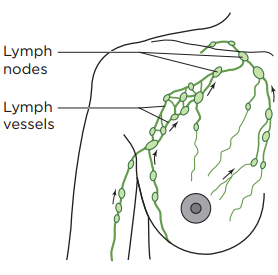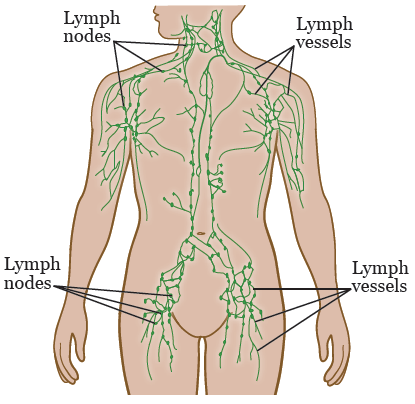This information explains your sentinel (SEN-tih-nul) lymph node biopsy at MSK.
You may have this procedure if you have breast cancer or melanoma (a type of skin cancer). It will help your doctor see if cancer cells have spread beyond the tumor to your lymph nodes.
About your lymphatic system and lymph node locations in your body

Your lymphatic (lim-FA-tik) system has 2 main jobs:
- It helps fight infection.
- It helps drain fluid from areas of your body.
Your lymphatic system is made up of lymph nodes, lymphatic vessels, and lymphatic fluid (see Figures 1 and 2).
- Lymph nodes are small, bean-shaped glands found along your lymphatic vessels. Lymph nodes filter your lymphatic fluid, taking out bacteria, viruses, cancer cells, and other waste products.
- A sentinel lymph node is the first lymph node that cancer cells often spread to. This means it’s the first lymph node a tumor drains into. Sometimes, there can be more than 1 sentinel lymph node that a tumor drains into. A sentinel lymph node is also called a sentinel node.
- Lymphatic vessels are tiny tubes (like your blood vessels) that carry lymphatic fluid to and from your lymph nodes.
- Lymphatic fluid is the clear fluid that travels through your lymphatic system. It carries cells that help fight infections and other diseases.

About your sentinel lymph node biopsy
A sentinel lymph node biopsy is a surgical procedure. During your biopsy, your surgeon will find your sentinel lymph node(s) and take them out. Then, they will send the sentinel lymph node sample to a lab to be checked for cancer cells.
If you’re only having a sentinel lymph node biopsy, your procedure will take about 30 minutes. However, many people have the biopsy during their breast or melanoma surgery. If this is the case, your surgery will take longer than 30 minutes. Your healthcare provider will tell you what to expect.
Before your sentinel lymph node biopsy
Before your biopsy, read Getting Ready for Surgery (www.mskcc.org/pe/getting_ready_surgery). It explains how to get ready for your biopsy. Your nurse will give you this resource.
The day of your sentinel lymph node biopsy
When it’s time for your procedure, you will get anesthesia (medication to make you sleep).
Once you’re asleep, the first thing your surgeon will do is find your sentinel lymph node(s). To do this, they will inject a small amount of blue dye near the site of the tumor. The dye will travel in your lymphatic fluid to your sentinel lymph node(s). It will stain your sentinel lymph node(s) blue.
Once your surgeon finds the area with your sentinel lymph node(s), they will make an incision (surgical cut). The sentinel lymph node(s) will be blue from the blue dye, allowing your surgeon to see them. They will take out the blue sentinel lymph node(s) and send them to the Pathology Department right away. A pathologist is a doctor who uses a microscope to diagnose disease. They will look at the sentinel lymph node sample under a microscope to check for cancer cells.
If the pathologist does not see any cancer cells, the cancer probably has not spread. Your surgeon will not take out any more lymph nodes.
If the pathologist sees cancer cells, this means there’s a higher chance the cancer has spread. You may need to have more lymph nodes taken out and checked for cancer cells. Your surgeon can do this during your biopsy or in a follow-up procedure called a lymph node dissection (dy-SEK-shun). If a lymph node dissection is needed, your surgeon will talk with you about it in more detail.
After the biopsy, your surgeon will close your incision(s) with sutures (stitches) under your skin. They may place Steri-Strips™ (thin pieces of surgical tape) or Dermabond® (surgical glue) over your incision(s). They may also cover your incision(s) with a bandage.
After your sentinel lymph node biopsy
You may go home the same day as your biopsy, or you may need to stay in the hospital. This depends on how many other surgeries you had that day. Your healthcare provider will tell you what to expect.
Once you’re home, read Caring for Yourself After Your Sentinel Lymph Node Biopsy (www.mskcc.org/pe/caring_after_sentinel_node_biopsy). It gives information about what to expect after your biopsy and explains how to care for yourself.